Round Cut Diamond Buying Guide
How to find the perfect round shape diamond for your engagement ring
We are reader-supported. Buying through any red colored link on our site may earn us commissions. Learn More.
How to find the perfect round shape diamond for your engagement ring
The round-cut diamond is renowned for its unmatched brilliance and timeless appeal. Round brilliant cut diamonds have either 57 or 58 facets and the symmetrical design ensures maximum light reflection. This is why two-thirds of diamond shoppers select a round cut. Round diamonds are typically the most expensive diamond shape. When buying a round diamond focus on well cut H-J color and VS2-SI2 clarity to maximize value. For example, a one carat round diamond (H color, VS2 clarity) will cost $4,000.
The round cut diamond is as exquisite as it is timeless. It is no wonder you are considering one for your engagement ring. In this article we help you balance the 4 C’s to get the perfect blend of quality and value when purchasing a round cut diamond.
What is a round cut diamond?
Why are round cut diamonds so popular?
How to choose the right cut quality?
What is a round brilliant cut diamond?
What is an Old European cut diamond?
How to choose the right diamond clarity?
How to choose the right diamond color?
Is carat weight important for a round cut diamond?
Why are round cut diamonds so expensive?
What setting style should I choose for a round cut diamond?
Bottom line recommendation
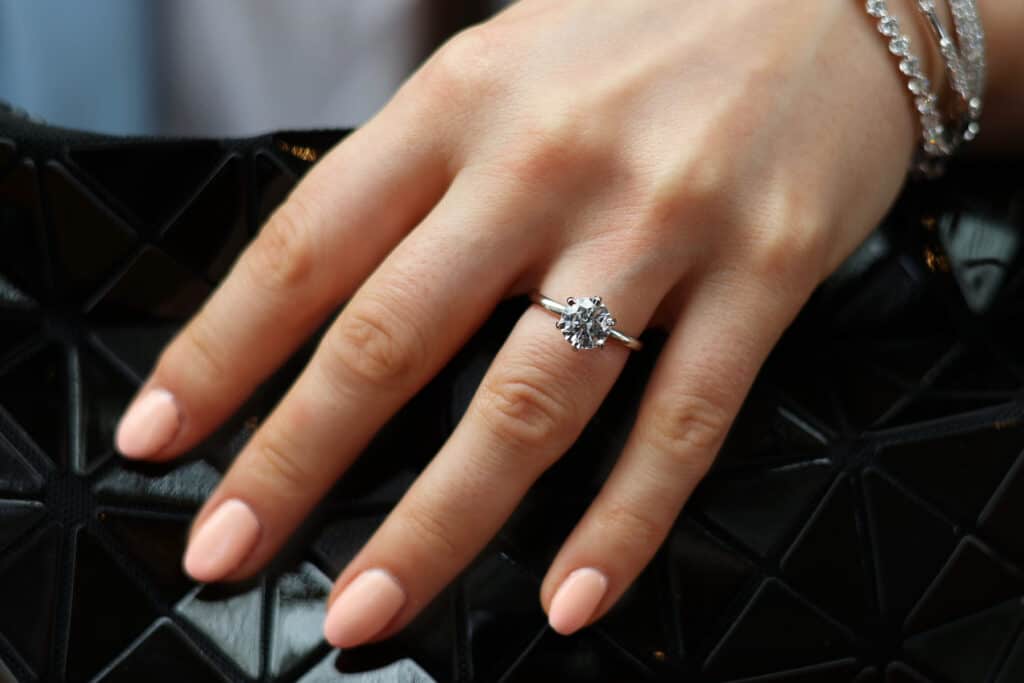
As the most popular diamond shape, the round cut diamond represents a large majority of all diamonds sold. In fact, data from diamond vendors suggests that around two thirds of consumers opt for the round cut when choosing a diamond.
“Round-cut diamonds continue to be the most popular shape in most states, accounting for 66% of nationwide orders, [Blue Nile] said last week.” Rapaport.com
The round brilliant cut boasts 58 facets (including the culet) and offers exceptional white light reflection, also known as brilliance. With a classic, timeless appearance, round brilliant cuts are often used in engagement rings, necklaces and other fine jewelry pieces. This 1 carat stone from James Allen is a stunning example of a round brilliant cut.
In 1919, Marcel Tolkowsky created a surge of interest in the round cut diamond by publishing his work, “Diamond Design: A Study of the Reflection and Refraction of Light in Diamond” which highlighted the ideal cut aspects of a round brilliant. Since Tolkowsky’s influence, the round cut has remained the most common diamond cut.
Why you should trust us
During the Victorian, Edwardian and Art Deco eras, the Old European cut was a popular diamond choice. As knowledge and technology advanced over time, diamond cutting techniques became more refined. Cut design progressed toward larger tables, smaller culets and longer, leaner facets. While Old Europeans were cut primarily for color, the round brilliant is cut for brilliance.
The primary difference between the Old European and the round cut is that the Old European maintains facets with triangular blocks while the round brilliant has thinner facets. Some customers enjoy the vintage style and personality of the Old European, though most prefer the brilliance of the round cut.
The term “round cut” is used in the diamond industry, but understand this refers to the shape of the diamond. There is no difference between a round cut diamond and a round shape – so if someone mentions a round cut, round brilliant cut or round shaped diamond, this all means the same thing.
A round cut diamond is very popular amongst celebrities as well. For example, Margaret Qualley is rocking a very elegant six prong solitaire engagement ring with a round cut diamond in the center.
Here are some of the most noticeable features of round cut diamonds, including the proportions of an excellent cut round diamond.
Round cut diamonds are the most popular diamond shape. In fact, they make up between two thirds and 75% of all diamonds sold, and about 60% of all engagement rings.
Here are the main reasons round cut diamonds are highly sought after for engagement rings:
A large part of the beauty and brilliance of the round brilliant cut comes from its unique facet pattern, which provides incredible light performance. As the GIA explains:
“The crown facets, consisting of 8 bezels, 8 stars, and 16 upper halves, gather and disperse light to create brightness, fire, and a scintillating pattern of light and dark. The pavilion facets, consisting of 16 lower halves, 8 mains, and an optional culet, reflect the light back through the crown to the viewer’s eye. All of these facets work together creating each diamond’s unique appearance.” Gemological Institute of America (GIA)
While the round cut diamond is by far the most popular diamond shape, there are many more shapes that are popular with people looking for a different, more unique look. Head over to our dedicated page covering all the diamond shapes you may want to consider.
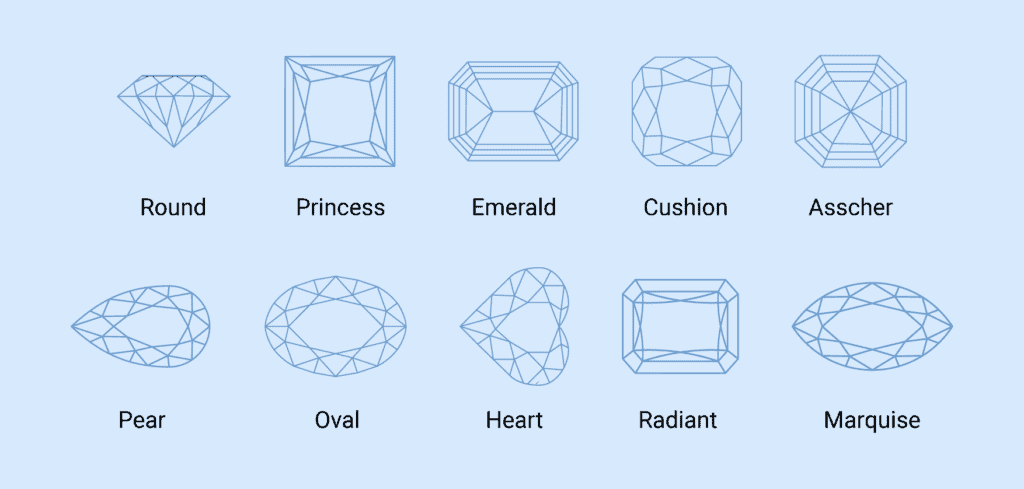
Of all the characteristics, diamond cut is the element that most heavily impacts a diamond’s beauty. It encompasses how well-proportioned and aesthetically appealing a diamond is. Cut proportions affect a diamond’s ability to reflect light and provide brilliance.
Cut is the most important of the 4 Cs of diamond quality. While you can settle for a low grade in clarity or color, or find a beautiful diamond at a low carat weight, rarely (if ever) will you find a passable diamond when settling for a lower than ideal cut grade.
A poorly cut diamond is going to end up dull or oddly proportioned and will render all other qualities rather irrelevant.
The GIA is a well-respected and renowned lab grading entity that issues reports for diamonds. They grade round brilliant cuts on the following scale:
| Excellent |
|
| Very Good |
|
| Good |
|
| Fair |
|
| Poor |
|
While GIA grade is important, it is not the sole aspect to consider when it comes to cut. Be sure to keep this in mind as you search for diamonds, as roughly 55% of all GIA round diamonds listed on the internet are excellent cuts. This means there is a wide range of “excellence” within their grade (ranging from truly stunning to mediocre).
To evaluate a diamond’s cut quality, ensure it is not cut too shallow or too deep.
When a round brilliant is cut too shallow, incoming light strikes the pavillion at a low angle. The light then travels through the diamond and exits through the sides, without reflecting through the table to the eyes. The large amount of escaping light causes the diamond to lack both brilliance and fire.
If a diamond is cut too deep, light will strike the pavillion at a sharper angle, prompting the light to reflect to another pavilion and exit through the bottom of the diamond—instead of through the table. For this reason, when a diamond is cut too deep, it will be dull instead of radiant.
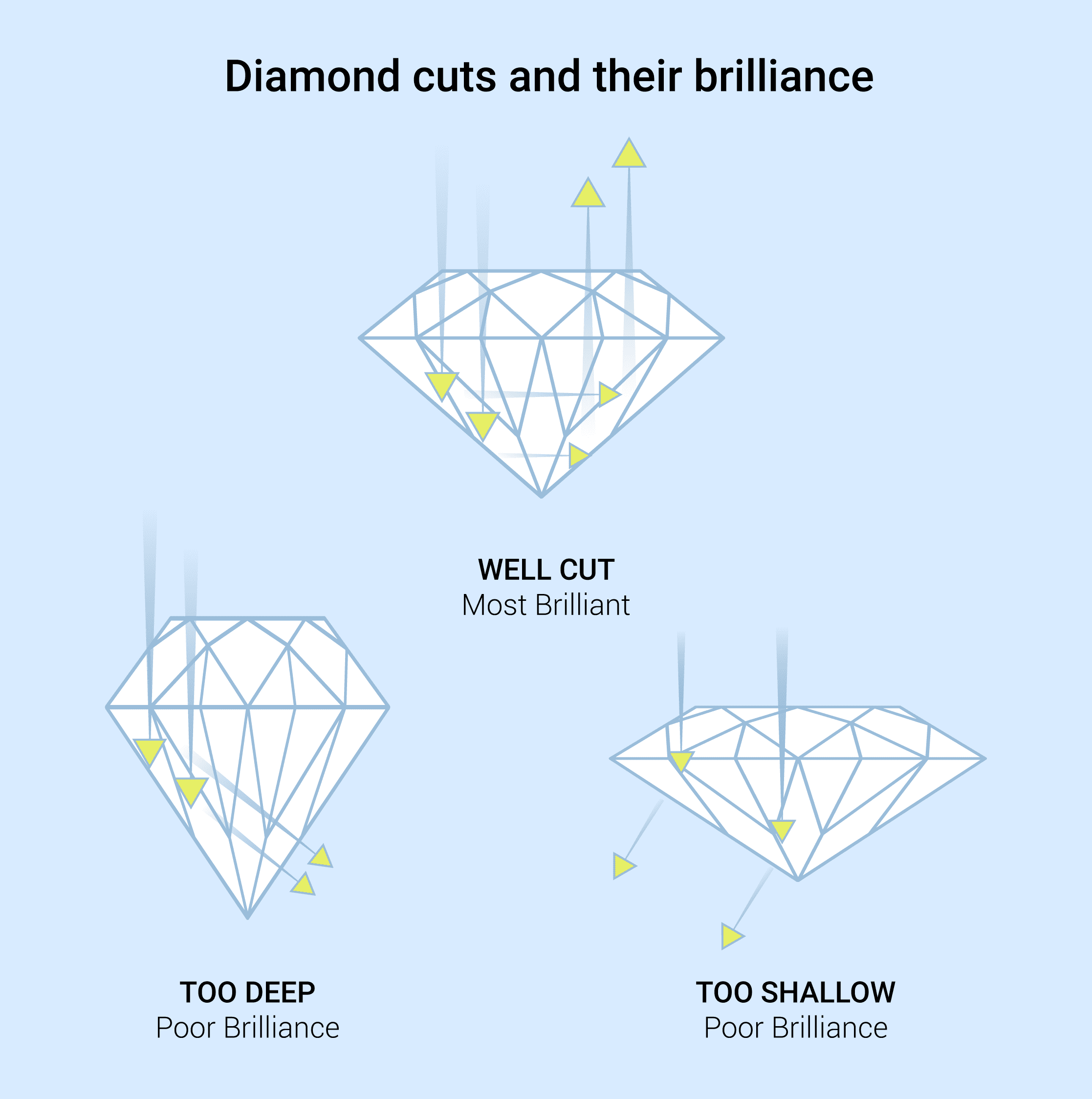
When a diamond is cut for maximum brilliance and fire, light strikes each pavilion and reflects back to the eye through the crown and table. A well-proportioned round cut diamond with optimal facet angles reflects white and colored light almost flawlessly.
Because cut quality has the greatest impact on a diamond’s beauty, we strongly recommend detailed attention in this area. If you’re working within a budget, consider reducing your carat weight to ensure you purchase a high-quality cut.
Rather than making a decision based solely on a grading report, review the diamond closely and ask for an expert’s opinion.
A brilliant cut diamond refers to a specific form of cut that utilizes numerous facets to reflect white light particularly well. The round brilliant cut, for example, has 58 facets (including the culet) and is a cone-like shape, like this excellent cut round diamond from James Allen.
A depiction of a brilliant cut’s facets—including its crown, pavilion and table facets—is displayed in the image below. Depths, angles and proportions work together to generate a diamond’s ability to emit fire and brilliance. Because brilliant cuts have a large number of carefully constructed facets, light reflects off them in a remarkable way.
Brilliant cut diamonds come in a number of different shapes. Round brilliant diamonds are the most popular, however, there are also princess cut, cushion cut, and oval or pear shaped diamonds that come as part of the same family of brilliant cuts.
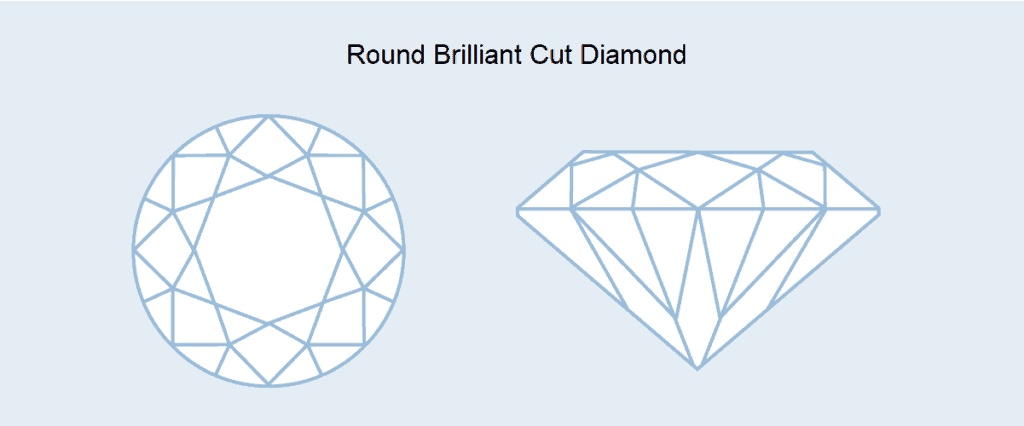
The Old European Cut is similar to the round brilliant, but it was designed prior to modern diamond technology. Old European cuts generally have smaller tables, heavier crowns and deeper proportions than the modern round brilliant cut.
The GIA currently considers the following to be a diamond with an Old European cut:
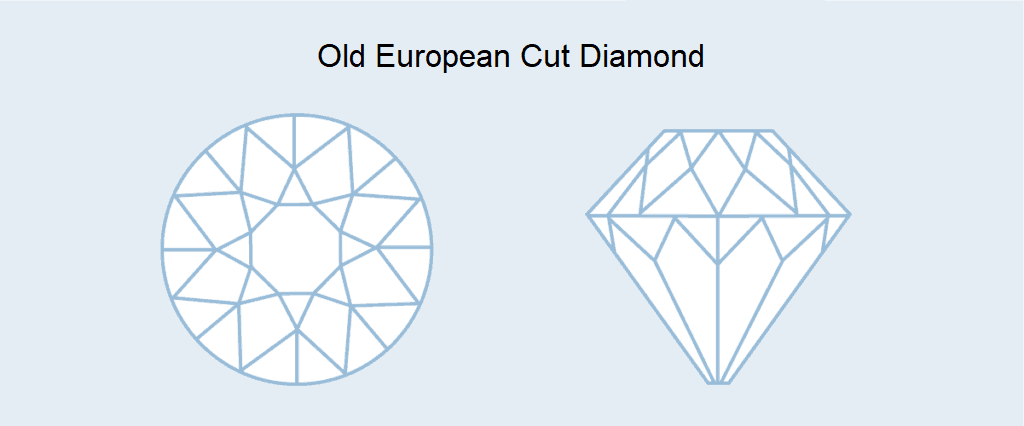
Diamond clarity refers to the visual appearance of inclusions and blemishes in a stone.
The GIA grades clarity on the following scale (from cleanest to most included):
For the round cut diamond, or any diamond shape for that matter, it is most important to determine if the diamond is eye-clean—rather than simply reading the clarity grade on a report. In other words, do you see any inclusions, blemishes or dark spots when looking at the diamond without magnification? In many cases, a VVS2 diamond and a VS1 diamond appear identical to the naked eye: free of any inclusions. Although they will look the same to you, the cost of the VVS2 will be much higher. For example, this stunning SI2 diamond from James Allen saves you almost 25% over a mediocre VS2 like this one.
In addition to looking for inclusions, watch for their locations. If blemishes rest on the perimeter, they will be harder to see through the diamond’s table. They may also be covered by jewelry prongs when the diamond is set. Check out our guide on VVS diamonds for more information on how to locate inclusions.
As a general guideline, we suggest looking for a diamond that is eye clean, and not choosing a higher clarity grade than this. There is no reason to go higher than this; you will simply pay more for something that will go unnoticed. As an example, you may find a stunning S1 with inclusions near the edge like this beauty from Blue Nile, making them hardly noticeable or covered by jewelry prongs once set in a ring.



Eye-Cleanliness is Paramount
In our opinion, a consumer’s goal should be to find the cheapest (in regards to clarity; other factors matter as well) eye-clean diamond you can find. We use “eye-clean” to describe diamonds that may have inclusions if you look at them with a magnifying glass (or microscope or loupe), but the typical person can’t see the inclusion with their naked eye.
To help you pick out an eye-clean round cut diamond, we have recently developed Ringo. Ringo is a patented artificial intelligence model that can examine videos of diamonds and determine if they are eye-clean. Ringo will also filter for other parameters like making sure the diamond is well-cut, doesn’t have fluorescence issues and will match the style setting you choose.
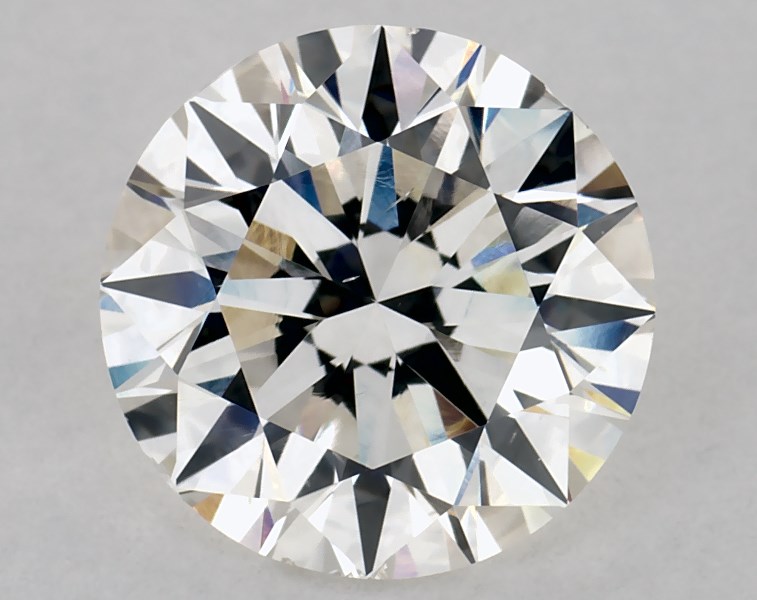


Review the diamond closely yourself and ask an expert to double-check your work before making a purchase.
Because round brilliant cuts reflect more light than any other diamond shape, color is more difficult to distinguish. The diamond’s multiple facets and high level of brilliance contribute to concealing color, making color a component that should be reviewed but not overemphasized.
On a scale from D to Z, a GIA lab report will indicate the level of tint or color within a diamond. D signifies a clear, colorless diamond; Z means an easily recognizable brown or yellow tint. To the naked eye, however, the differences between two adjacent grades (such as F and G color) are rarely noticeable.
For a closer look at the slight difference between diamond color grades, let’s review the chart below. In the image, two sets of identical diamonds are shown. On the right, the nine diamonds are arranged face down in order based on their color grade. On the left, the diamonds are arranged randomly.
When looking at the photos on the left, are you able to identify the correct grading order?
(Answers (left side): First Row = G, L, E. Second Row = F, J, D. Third Row = H, K, I.)
As you probably noticed, the eye has a difficult time deciphering any one element of a diamond, such as color, in this case. As another example, the color of this H graded diamond with SI2 clarity in a 14K white gold setting from James Allen looks identical to the color of this I graded diamond with SI2 clarity in a similar setting, but the price of the H graded diamond is nearly 8% more. Even an expert would have a hard time noticing the color difference under 10x magnification.
In addition to reviewing the diamond for color, consider the setting that will be used. A diamond should appear colorless in relation to its setting. In general, we recommend the J color for white gold solitaire rings and K or L Color for yellow gold solitaire rings. We strongly encourage viewing the diamond closely and asking an expert for assistance. It could save you hundreds or even thousands of dollars in an area that will likely go unnoticed to the naked eye.
For more information on diamond color, check out our diamond color guide.
Diamond carat, which is a measure of the weight of a diamond, is a key consideration to make when buying a round cut diamond.
Higher carat weight comes with a larger price tag, for one thing. The diamond cost per carat does not stay the same at each level. For example, a 1 carat diamond is more than 2x the price of a 0.50 carat diamond, and a 2 carat diamond is more than 2x the price of a 1 carat diamond. The difference in price per carat gets progressively bigger as carat weight goes up, so be prepared to pay a premium for high-carat diamonds.
While diamond carat is often mistakenly referred to as a measure of diamond size, there is a correlation between carat weight and size, and higher carat diamonds are almost always bigger as well. This is generally desirable – however, be aware that with a larger diamond, imperfections are easier to see, so you may need to go higher in diamond clarity for a higher carat diamond as well.
To imagine what the difference is between carat weights, we made this simple comparison to a US quarter:
Round cut diamonds are the most expensive diamond shape, and for good reason.
First, when round diamonds are cut, a large portion of the rough stone must be removed. Usually, only 40% of the original stone remains at the end of the cut and polish process. As a comparison, princess cut diamonds use about 80% of the stone’s original weight. The lower yield of a round cut means a higher price because more rough stone is needed.
Second, the popularity of round cut diamonds boosts the price. Approximately 60% of all engagement rings are made with a round cut diamond. Like other goods and commodities, the higher the demand, the higher the price.
Third, the unmatched brilliance and beauty of a round cut diamond warrants a higher price. Its classic appeal and versatile shape make it a sophisticated choice.
In our opinion, the advantages of a round cut justify the price. If you’d like help searching for a round cut diamond in your price range, contact us.
You can set a round cut diamond in any kind of ring, from a side stone setting to a tension setting. There are a few styles, though, that are particularly flattering for a round cut stone. Find out how to design your own engagement ring in our article.
Solitaire settings: The simplicity of a solitaire setting lets the brilliant round diamond take center stage. From yellow gold to platinum settings, the solitaire will never go out of style.
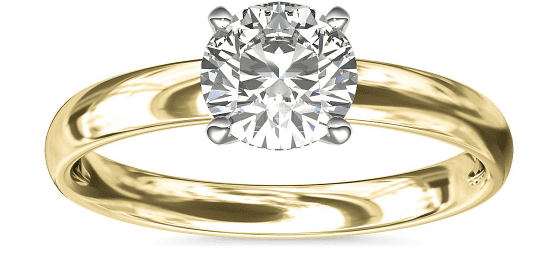
Halo settings: A gorgeous halo of smaller stones makes a round brilliant diamond sparkle even more. A halo setting can add character and size to any round diamond.
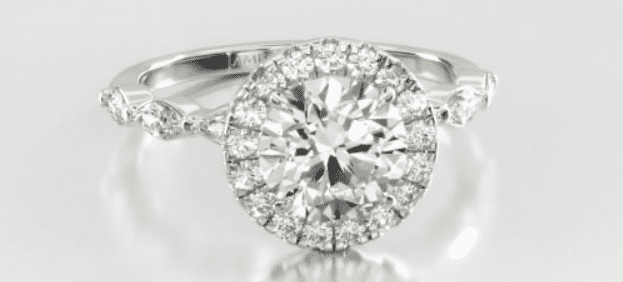
Pavé settings: A pavé setting brings elegance and character to a round cut diamond. It also adds sparkle to the engagement ring.
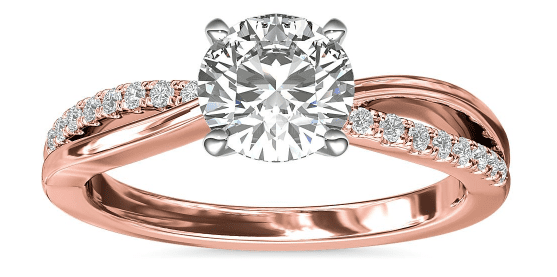
Vintage settings: For those who appreciate antique style, there are a myriad of vintage round cut engagement rings. The intricate design can enhance a round cut stone.
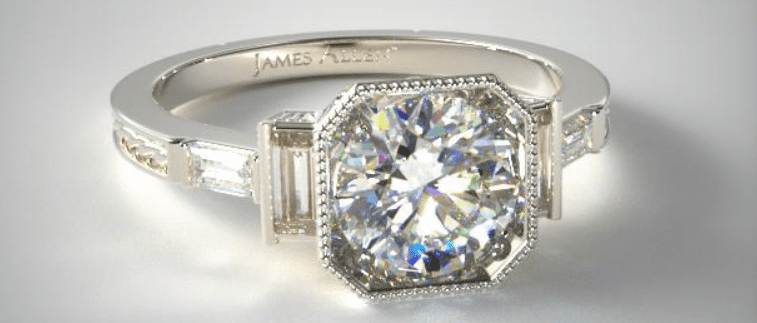
Shop for round cut diamond engagement rings here.
If you’re looking for a timeless diamond with impressive brilliance, a round cut diamond may be the perfect choice. Consider first the quality of the diamond’s cut, then its color and clarity, to ensure the most stunning round cut diamond.
To confirm you’re making a smart purchasing decision, contact one of our experts who can help with reviewing and identifying high quality diamonds.
When it comes to quality, we recommend looking for a diamond that is eye-clean like this beautiful SI1 from James Allen. To go higher than that in Clarity is paying for something that will go unnoticed. For Color, we recommend the J Color for white gold solitaire rings like this beautiful Round Cut in a 18K white gold setting from James Allen. And for yellow gold solitaire rings, we recommend K or L Color like this Round Cut in 18K yellow gold.




Before you buy a diamond, get personal buying advice from industry veterans. We'll help you get the best diamond for the money.
DISCLAIMER: We don't use your email for marketing. Period.
A diamonds’ price is determined primarily by the 4 Cs of the diamond. On the wholesale level, diamond prices are first based on a diamond shape and
Buying an engagement ring is often one of the first major purchases in a person's life. The process can be fraught with tension as there are so m
A wide range of 1 carat diamonds exist both in online markets and local diamond jewelry stores. Not only are there significant differences in beauty
Please enter your email address to receive your 25% off coupon code:
Here is your coupon code: GFDSF3GF